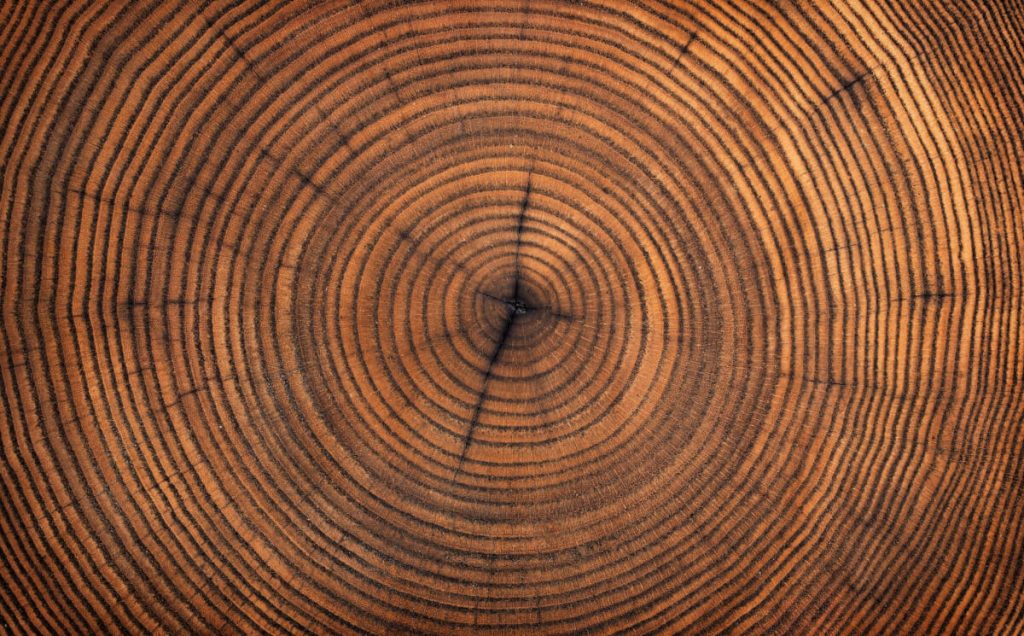

The width and color of tree rings provides an extraordinary glimpse into a tree’s history. (Dmitr1ch/Shutterstock)
How extreme weather leaves a lasting mark on trees and shrubs
POZNAŃ, Poland — In the Arctic’s harsh borderlands, where trees wage a constant battle for survival, an international research team has discovered that extreme cold leaves lasting fingerprints in wood. These “blue rings,” visible only under a microscope, reveal centuries-old stories of climate disasters that once brought summer temperatures plunging to near-freezing.
The study, published in Frontiers in Plant Science, examined pine trees and juniper shrubs in the Arctic. The research team ventured to Mount Iškoras in northern Norway, where these plants battle harsh Arctic conditions. Here, at the northern limit of where trees can survive, they uncovered a natural record of historical cold events preserved in wood.
“Blue rings look like unfinished growth rings, and are associated with cold conditions during the growing season,” explains lead author Dr. Agata Buchwal from Adam Mickiewicz University, in a statement. “In general, we found more blue rings in trees than in shrubs. Shrubs seem to be more adapted to cooling events than trees, which is probably why shrubs are found further north.”
What are tree rings?
Tree rings are the circular patterns you see inside a tree trunk when it’s cut crosswise. Each ring represents one year of the tree’s life, with the width and color of the rings reflecting the tree’s growth conditions that year. Wider rings often mean the tree grew in good conditions, like a warm, wet year, while narrow rings can indicate tough times, such as drought or extreme cold. Scientists study tree rings to learn about a tree’s age and the environmental history of the area where it grew.
The scientists collected core samples from 25 Scots pine trees and stem discs from 54 juniper shrubs, creating paper-thin sections that they stained with special dyes. Under a microscope, normal growth appears red, while sections affected by cold turn blue – revealing years when growth was disrupted by extreme temperatures.
Their analysis showed two years that stood out dramatically. In 1902, almost every pine tree (96%) and most junipers (68%) formed blue rings. The next most significant event was in 1877, affecting 84% of pines and 36% of junipers. The timing of these cold snaps proved crucial. The 1902 event struck in June, when trees normally begin their growing season, while 1877’s cold spell hit in August.
“In the case of pine trees in boreal regions, blue rings have the potential to weaken the tree, making it more susceptible to mechanical damage or disease,” says second author Dr. Pawel Matulewski of Adam Mickiewicz University. “If this phenomenon persists over several years, it can impede the tree’s recovery in following years.”


These dramatic cold events might have had an explosive trigger. The 1902 cold snap coincided with the eruption of Mount Pelée on the Caribbean island of Martinique in May of that year. Similarly, Ecuador’s Cotopaxi volcano erupted in late June 1877, potentially contributing to August’s cold temperatures. However, researchers note there’s no other evidence linking this eruption to cooling in northern Norway.
“We hope to inspire other research groups to look for blue rings in their material,” says Buchwal. “It would be great to establish a blue ring network based on trees and shrubs to reconstruct cooling events at the northern treeline over long timescales.”
While modern technology provides sophisticated ways to monitor climate, these blue rings show that nature has been keeping its own records all along. As researchers continue to study them, they’re uncovering new chapters in Earth’s climate history written in wood.
Paper Summary
Methodology Explained
Researchers collected core samples from living pine trees and cross-sections from both living and dead juniper shrubs from 150 years of growth. They created extremely thin slices of wood (15-30 microns thick) and stained them with a mixture of two dyes – Safranin and Astra Blue. This staining technique makes it easy to identify areas where cell walls didn’t properly harden, as these sections turn blue while normal wood turns red. They then measured various characteristics of the cells using microscopes and specialized software.
Key Results
The study found that blue rings formed primarily when mean monthly temperatures fell below specific thresholds – 5.3°C in June or 7.6°C in August. Pine trees showed blue rings in 2.1% of their total rings examined, while junipers showed them in 1.3%. The 1902 cold event affected nearly all studied pines and over two-thirds of junipers, making it the most significant event in the record.
Study Limitations
The research was limited by gaps in historical temperature data and the relatively small number of extreme cold events during the study period. Additionally, the temperature measurements came from a weather station about 20km away and at a lower elevation than the study site, meaning actual temperatures at the tree locations were likely even colder than recorded.
Discussion and Takeaways
This research provides the first evidence showing how early versus late summer cooling events affect tree growth differently at the northern treeline. It suggests that trees are particularly vulnerable to early-season cold snaps, which can impact their growth not just during the event but in subsequent years as well. The findings could help improve our understanding of past climate events and their impacts on forest ecosystems.
Funding and Disclosures
The research was supported by multiple funding sources, including the National Science Centre, Poland, the Polish National Agency for Academic Exchange, and the Slovenian Research and Innovation Agency. The authors declared no conflicts of interest.
Publication Information
The study, titled “Blue rings in trees and shrubs as indicators of early and late summer cooling events at the northern treeline,” was published in Frontiers in Plant Science on January 22, 2025.







